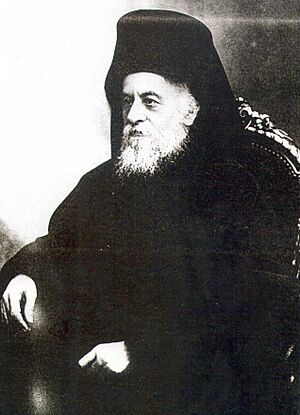Gregory VII of Constantinople facts for kids
Quick facts for kids |
|
|---|---|
| Ecumenical Patriarch of Constantinople | |
 |
|
| Church | Church of Constantinople |
| In Office | 6 December 1923 – 17 November 1924 |
| Predecessor | Meletius IV of Constantinople |
| Successor | Constantine VI of Constantinople |
| Personal details | |
| Birth name | Gregory Zervoudakis |
| Born | 21 September 1850 |
| Died | 17 November 1924 (aged 74) |
Gregory VII (Greek: Γρηγόριος Ζʹ) was a very important leader in the Eastern Orthodox Church. His birth name was Gregorios Zervoudakis. He was born on September 21, 1850, and passed away on November 17, 1924. From 1923 until his death in 1924, he held the title of Ecumenical Patriarch of Constantinople. This means he was the main spiritual leader for many Orthodox Christians around the world. Before becoming Patriarch, he was a high-ranking church official called the Metropolitan of Chalcedon.
One of his big decisions was bringing the New Style Calendar to the Church of Constantinople. This changed how many church holidays were celebrated. He died suddenly in 1924 from a serious heart attack.
Contents
Who Was Patriarch Gregory VII?
Gregory VII was a significant figure in the history of the Church of Constantinople. He served as its spiritual head during a challenging time. His leadership involved making important decisions for the church and its followers.
Early Life and Education
Gregory was born in a place called Stavri, on the island of Sifnos. He went to a special school for religious studies called the Theological School of Halki. He finished his studies there in 1882. For his graduation, he wrote a paper about the truthfulness of the four Gospels, which are books in the Christian Bible. After school, he started his church service in the Diocese of Rhodes. He worked there as a deacon and later as a chancellor, which is a high-ranking assistant.
Becoming a Church Leader
As he grew in the church, Gregory was chosen for several important roles.
- In 1887, he became the bishop of Myreo.
- In 1892, he was made the metropolitan of Serres.
- In 1909, he became the metropolitan of Kyzikos.
- Finally, in 1913, he was chosen as the metropolitan of Chalcedon.
During a difficult period when the Church of Constantinople decided to stop working with the government of the Ottoman Empire, Gregory had a different opinion. He decided to step down from his leadership roles in the church council and returned to his own area, Chalcedon.
Election as Patriarch
After the previous Patriarch, Meletius IV, resigned in September 1923, the church leaders needed to choose a new one. This election happened after the Treaty of Lausanne was signed, which was a peace treaty that changed borders and rules. The Government of Turkey had a strict rule: the new Patriarch had to be a Turkish citizen.
On December 6, 1923, only the bishops who lived in Constantinople gathered to vote. They chose Gregory because he had stayed out of political arguments and had kept good relations with the Turkish authorities. After he was elected, Gregory sent a letter to the Turkish Government in Ankara to show his acceptance. However, not everyone agreed with his election. Papa Eftim I, who led a group called the Turkish Orthodox Church, and his followers were against it.
Important Decisions and Actions
Gregory officially became Patriarch on December 30, 1923. He made several important decisions during his short time as leader:
- On February 19, 1924, a church court removed Papa Eftim from his position because of his disagreements and challenging attitude.
- On May 10, 1924, another church leader, Metropolitan Vasilios, was also removed. He had started churches in America without the Patriarchate's permission.
- Gregory worked with the Greek Government to try and stop church members from being forced to move due to an agreement about population exchange between countries.
- In 1924, he officially recognized the independence, or autocephaly, of the Polish Orthodox Church. This meant it could govern itself.
- He also created new church regions, called Metropolises, in places like the Princes' Islands, Central Europe, and Australia.
His Final Years
In September 1924, Gregory became very ill with gallstones, which caused a serious condition called obstructive jaundice. Doctors could not treat it. He passed away on November 17 of the same year, at the age of 74.

